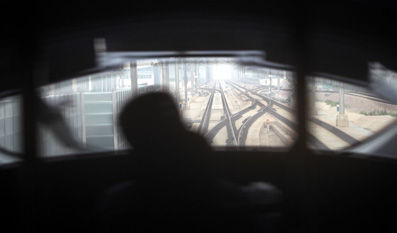
(Ecns.cn) -- China's high-speed rail construction is in full swing, with 3,500 kilometers of new lines planned this year. A byproduct of that expansion is blind urban sprawl around stations on high-speed lines, a growing problem that should not be ignored, Time Weekly reports.
The Beijing-Shanghai line has been very successful, transporting 52.6 million passengers between the two cities during its first year of operation, and ticket revenues have so far matched costs, according to the National Development and Reform Commission.
The route has also brought profits to cities along the way, as local governments have leapt at the opportunity to boost GDP growth.
Located about 40 minutes from Shanghai by bullet train, Wuxi East Railway Station in Wuxi, Jiangsu Province, is a good example. In only three years the area near the station, called Xidong New Town, has undergone a dramatic transformation.
Xidong emerged before the Beijing-Shanghai line went into operation, but following confirmation of the high-speed rail project in 2009, the area soon become swamped by property developers, according to Time Weekly.
Back then, the average price of housing was only 3,000 yuan (US$480) per square meter in Xidong; now it's higher than 6,000 (US$960), and sometimes exceeds 7,500 (US$1,200), says the magazine.
The Wuxi government has attempted to lure residents to Xidong New Town with a modern lifestyle replete with shopping malls, high class clubs and villa communities.
Yet the New Town's development has fallen well short of expectations: it has been unable to function as a sub-center of the city and, more importantly, to attract residents.
The phenomenon is often described as "shallow urbanization," or incomplete urbanization. Its victims are primarily farmers who are forced out when their land is taken by developers for hapless projects like Xidong New Town.
The problem is by no means limited to Wuxi, but plagues numerous locations along the Beijing-Shanghai High-Speed Railway.
There are 24 stations along that line, 22 of which are newly built. 16 of them are the result of the same development model as Xidong, writes Time Weekly.
In 2011, Changzhou, a prefecture-level city in Jiangsu, initiated a plan worth 20 billion yuan (US$3.2 billion) to build a new commercial town close to Changzhou North Railway Station.
In January, also in Jiangsu Province, Suzhou mapped out a "new town" covering an area of 28.52 square kilometers to support development near the high-speed rail.
In Jinan, capital of Shandong Province, the local government has also planned a new "sub-center" covering an area of 450 square kilometers near the Jinan South Railway Station.
It's fine for local governments to take advantage of the high-speed rails to improve less-developed areas of their cities, but it's very difficult to achieve the targets, an urban planning expert pointed out.
Suppose every city along the high-speed rail develops a "new town" – the consumption of natural and human resources would be outrageous, said Zhang Zhiyuan, dean of the Shandong Regional Economy Research Institute at Shandong Economic University.
Investment in development around high-speed rails is not an overnight cure for GDP growth, according to Time Weekly, but should be planned with scientific research.

Copyright ©1999-2011 Chinanews.com. All rights reserved.
Reproduction in whole or in part without permission is prohibited.